IT Fundamentals Assignment - University Name, 2019
VerifiedAdded on 2022/10/01
|7
|1435
|22
Homework Assignment
AI Summary
This IT Fundamentals assignment addresses key concepts in information technology and software development. The assignment begins with an explanation of the three-way handshake in TCP and contrasts it with a two-way handshake, emphasizing the need for synchronization and bi-directional communication. The solution then defines Rapid Application Development (RAD), listing its advantages (flexibility, reduced risk) and disadvantages (unsuitability for small projects, potential for scalability issues). Following this, the assignment explores the agile methodology, highlighting its benefits (high product quality, customer satisfaction) and drawbacks (poor resource planning, fragmented output). The concept of scope creep in project management is defined, and three strategies to mitigate it are provided. Finally, the assignment considers the potential users of a real-time glucose monitoring system developed by AAA Medical Devices, and identifies fact-finding techniques to gather requirements for the new system, including research, existing documents, and interviews. The document concludes with a bibliography of relevant sources.

Running head: IT FUNDAMENTALS
IT FUNDAMENTALS
Name of the Student
Name of the University
Author Note
IT FUNDAMENTALS
Name of the Student
Name of the University
Author Note
Paraphrase This Document
Need a fresh take? Get an instant paraphrase of this document with our AI Paraphraser
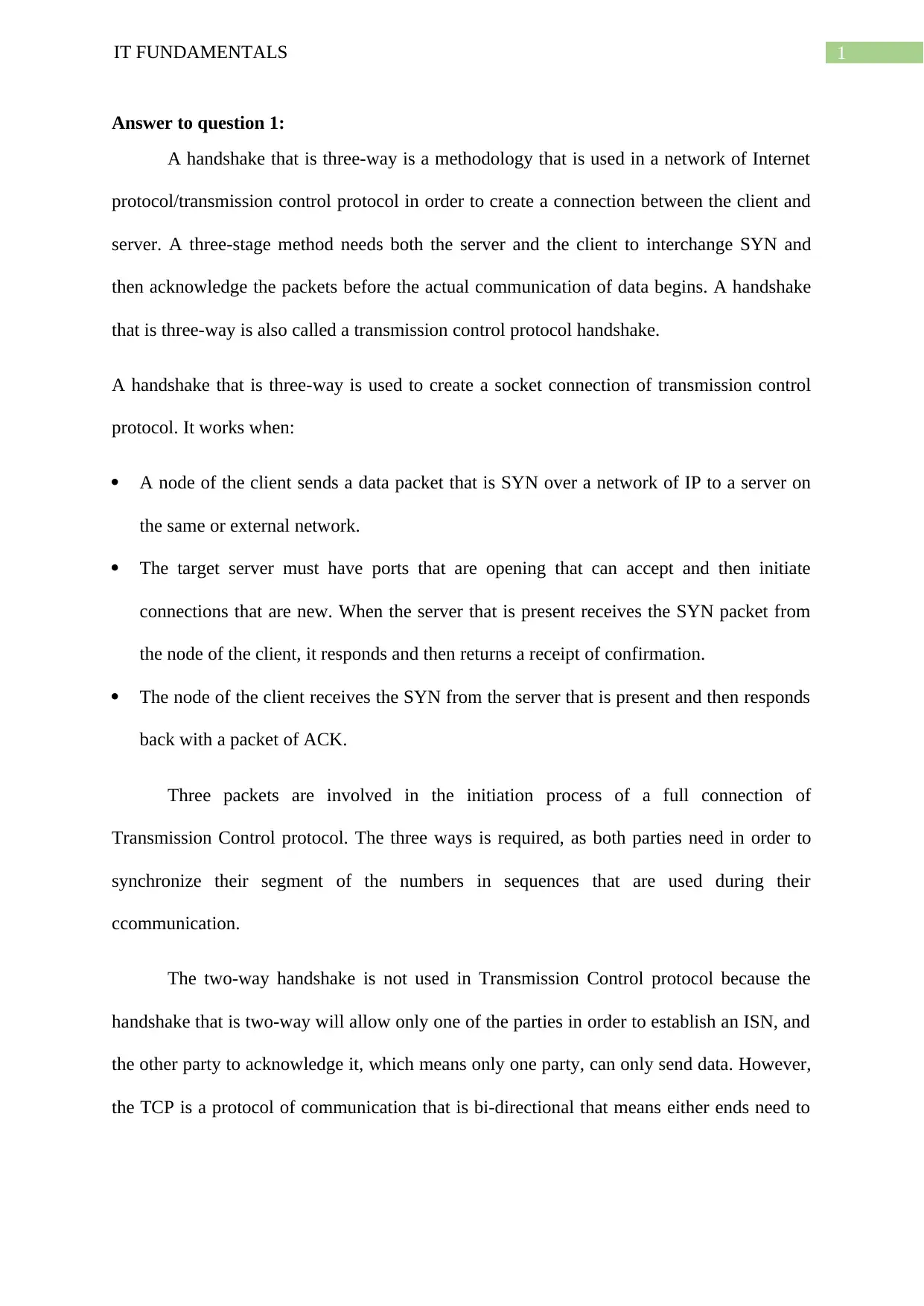
1IT FUNDAMENTALS
Answer to question 1:
A handshake that is three-way is a methodology that is used in a network of Internet
protocol/transmission control protocol in order to create a connection between the client and
server. A three-stage method needs both the server and the client to interchange SYN and
then acknowledge the packets before the actual communication of data begins. A handshake
that is three-way is also called a transmission control protocol handshake.
A handshake that is three-way is used to create a socket connection of transmission control
protocol. It works when:
A node of the client sends a data packet that is SYN over a network of IP to a server on
the same or external network.
The target server must have ports that are opening that can accept and then initiate
connections that are new. When the server that is present receives the SYN packet from
the node of the client, it responds and then returns a receipt of confirmation.
The node of the client receives the SYN from the server that is present and then responds
back with a packet of ACK.
Three packets are involved in the initiation process of a full connection of
Transmission Control protocol. The three ways is required, as both parties need in order to
synchronize their segment of the numbers in sequences that are used during their
ccommunication.
The two-way handshake is not used in Transmission Control protocol because the
handshake that is two-way will allow only one of the parties in order to establish an ISN, and
the other party to acknowledge it, which means only one party, can only send data. However,
the TCP is a protocol of communication that is bi-directional that means either ends need to
Answer to question 1:
A handshake that is three-way is a methodology that is used in a network of Internet
protocol/transmission control protocol in order to create a connection between the client and
server. A three-stage method needs both the server and the client to interchange SYN and
then acknowledge the packets before the actual communication of data begins. A handshake
that is three-way is also called a transmission control protocol handshake.
A handshake that is three-way is used to create a socket connection of transmission control
protocol. It works when:
A node of the client sends a data packet that is SYN over a network of IP to a server on
the same or external network.
The target server must have ports that are opening that can accept and then initiate
connections that are new. When the server that is present receives the SYN packet from
the node of the client, it responds and then returns a receipt of confirmation.
The node of the client receives the SYN from the server that is present and then responds
back with a packet of ACK.
Three packets are involved in the initiation process of a full connection of
Transmission Control protocol. The three ways is required, as both parties need in order to
synchronize their segment of the numbers in sequences that are used during their
ccommunication.
The two-way handshake is not used in Transmission Control protocol because the
handshake that is two-way will allow only one of the parties in order to establish an ISN, and
the other party to acknowledge it, which means only one party, can only send data. However,
the TCP is a protocol of communication that is bi-directional that means either ends need to
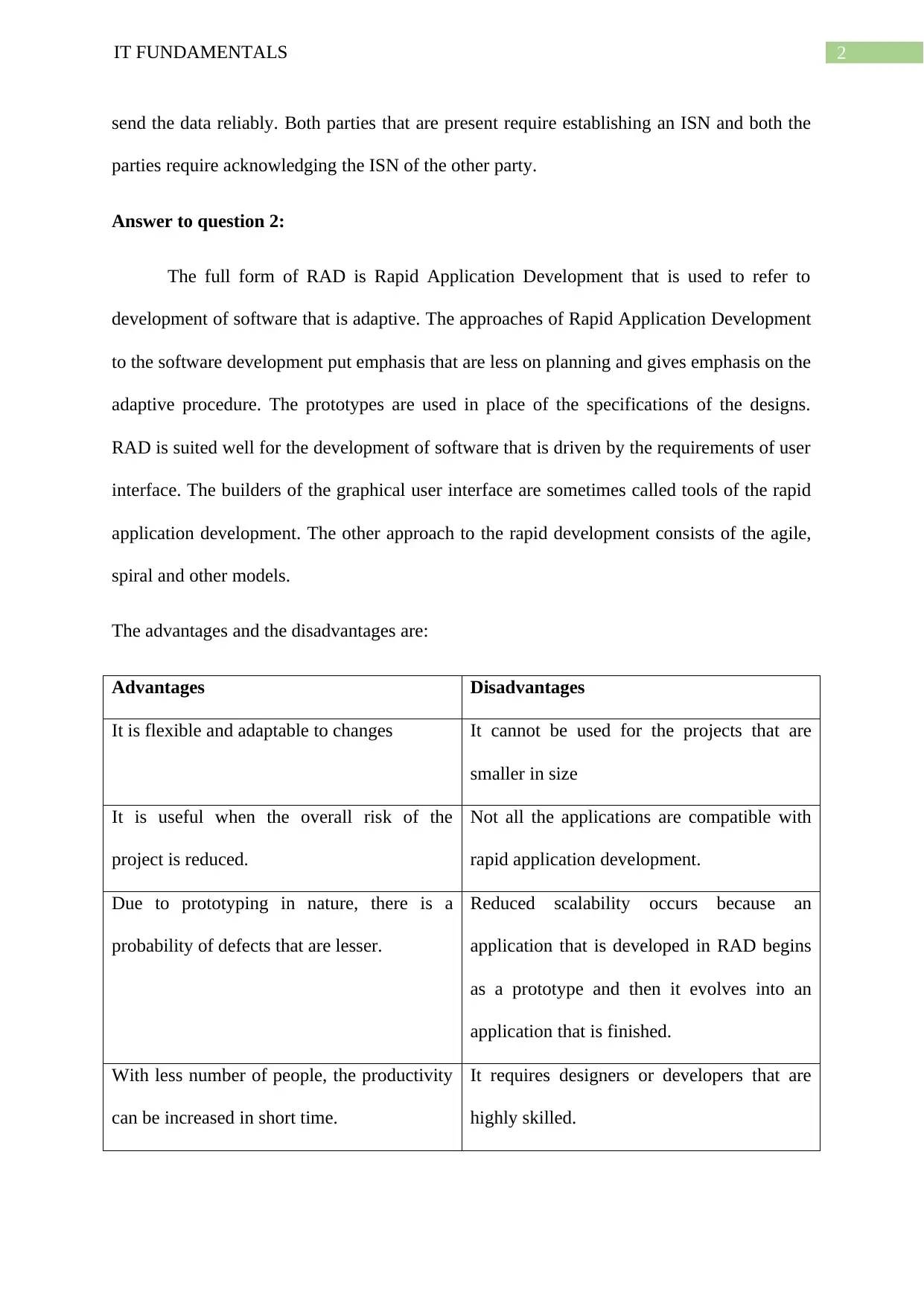
2IT FUNDAMENTALS
send the data reliably. Both parties that are present require establishing an ISN and both the
parties require acknowledging the ISN of the other party.
Answer to question 2:
The full form of RAD is Rapid Application Development that is used to refer to
development of software that is adaptive. The approaches of Rapid Application Development
to the software development put emphasis that are less on planning and gives emphasis on the
adaptive procedure. The prototypes are used in place of the specifications of the designs.
RAD is suited well for the development of software that is driven by the requirements of user
interface. The builders of the graphical user interface are sometimes called tools of the rapid
application development. The other approach to the rapid development consists of the agile,
spiral and other models.
The advantages and the disadvantages are:
Advantages Disadvantages
It is flexible and adaptable to changes It cannot be used for the projects that are
smaller in size
It is useful when the overall risk of the
project is reduced.
Not all the applications are compatible with
rapid application development.
Due to prototyping in nature, there is a
probability of defects that are lesser.
Reduced scalability occurs because an
application that is developed in RAD begins
as a prototype and then it evolves into an
application that is finished.
With less number of people, the productivity
can be increased in short time.
It requires designers or developers that are
highly skilled.
send the data reliably. Both parties that are present require establishing an ISN and both the
parties require acknowledging the ISN of the other party.
Answer to question 2:
The full form of RAD is Rapid Application Development that is used to refer to
development of software that is adaptive. The approaches of Rapid Application Development
to the software development put emphasis that are less on planning and gives emphasis on the
adaptive procedure. The prototypes are used in place of the specifications of the designs.
RAD is suited well for the development of software that is driven by the requirements of user
interface. The builders of the graphical user interface are sometimes called tools of the rapid
application development. The other approach to the rapid development consists of the agile,
spiral and other models.
The advantages and the disadvantages are:
Advantages Disadvantages
It is flexible and adaptable to changes It cannot be used for the projects that are
smaller in size
It is useful when the overall risk of the
project is reduced.
Not all the applications are compatible with
rapid application development.
Due to prototyping in nature, there is a
probability of defects that are lesser.
Reduced scalability occurs because an
application that is developed in RAD begins
as a prototype and then it evolves into an
application that is finished.
With less number of people, the productivity
can be increased in short time.
It requires designers or developers that are
highly skilled.
⊘ This is a preview!⊘
Do you want full access?
Subscribe today to unlock all pages.

Trusted by 1+ million students worldwide
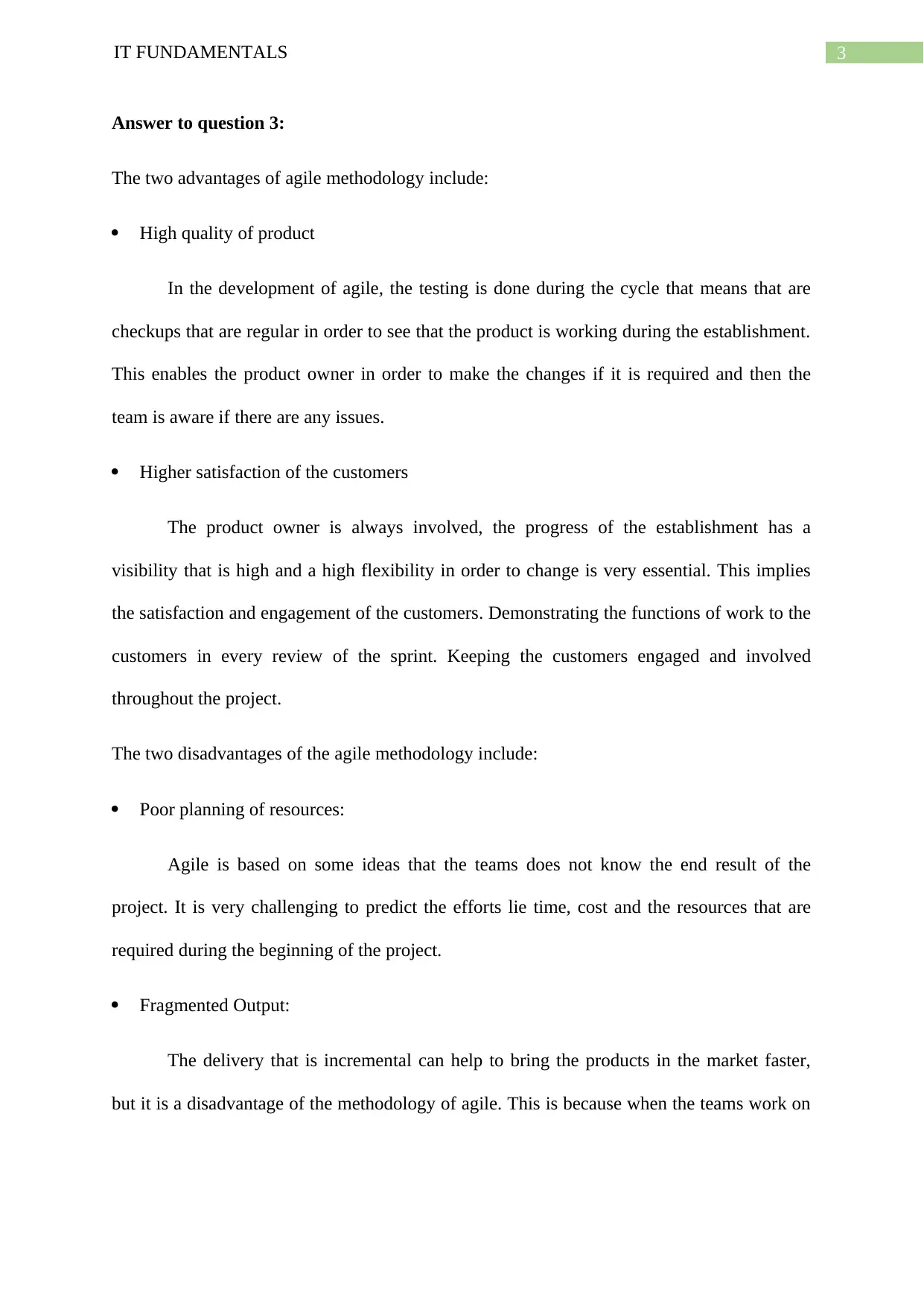
3IT FUNDAMENTALS
Answer to question 3:
The two advantages of agile methodology include:
High quality of product
In the development of agile, the testing is done during the cycle that means that are
checkups that are regular in order to see that the product is working during the establishment.
This enables the product owner in order to make the changes if it is required and then the
team is aware if there are any issues.
Higher satisfaction of the customers
The product owner is always involved, the progress of the establishment has a
visibility that is high and a high flexibility in order to change is very essential. This implies
the satisfaction and engagement of the customers. Demonstrating the functions of work to the
customers in every review of the sprint. Keeping the customers engaged and involved
throughout the project.
The two disadvantages of the agile methodology include:
Poor planning of resources:
Agile is based on some ideas that the teams does not know the end result of the
project. It is very challenging to predict the efforts lie time, cost and the resources that are
required during the beginning of the project.
Fragmented Output:
The delivery that is incremental can help to bring the products in the market faster,
but it is a disadvantage of the methodology of agile. This is because when the teams work on
Answer to question 3:
The two advantages of agile methodology include:
High quality of product
In the development of agile, the testing is done during the cycle that means that are
checkups that are regular in order to see that the product is working during the establishment.
This enables the product owner in order to make the changes if it is required and then the
team is aware if there are any issues.
Higher satisfaction of the customers
The product owner is always involved, the progress of the establishment has a
visibility that is high and a high flexibility in order to change is very essential. This implies
the satisfaction and engagement of the customers. Demonstrating the functions of work to the
customers in every review of the sprint. Keeping the customers engaged and involved
throughout the project.
The two disadvantages of the agile methodology include:
Poor planning of resources:
Agile is based on some ideas that the teams does not know the end result of the
project. It is very challenging to predict the efforts lie time, cost and the resources that are
required during the beginning of the project.
Fragmented Output:
The delivery that is incremental can help to bring the products in the market faster,
but it is a disadvantage of the methodology of agile. This is because when the teams work on
Paraphrase This Document
Need a fresh take? Get an instant paraphrase of this document with our AI Paraphraser
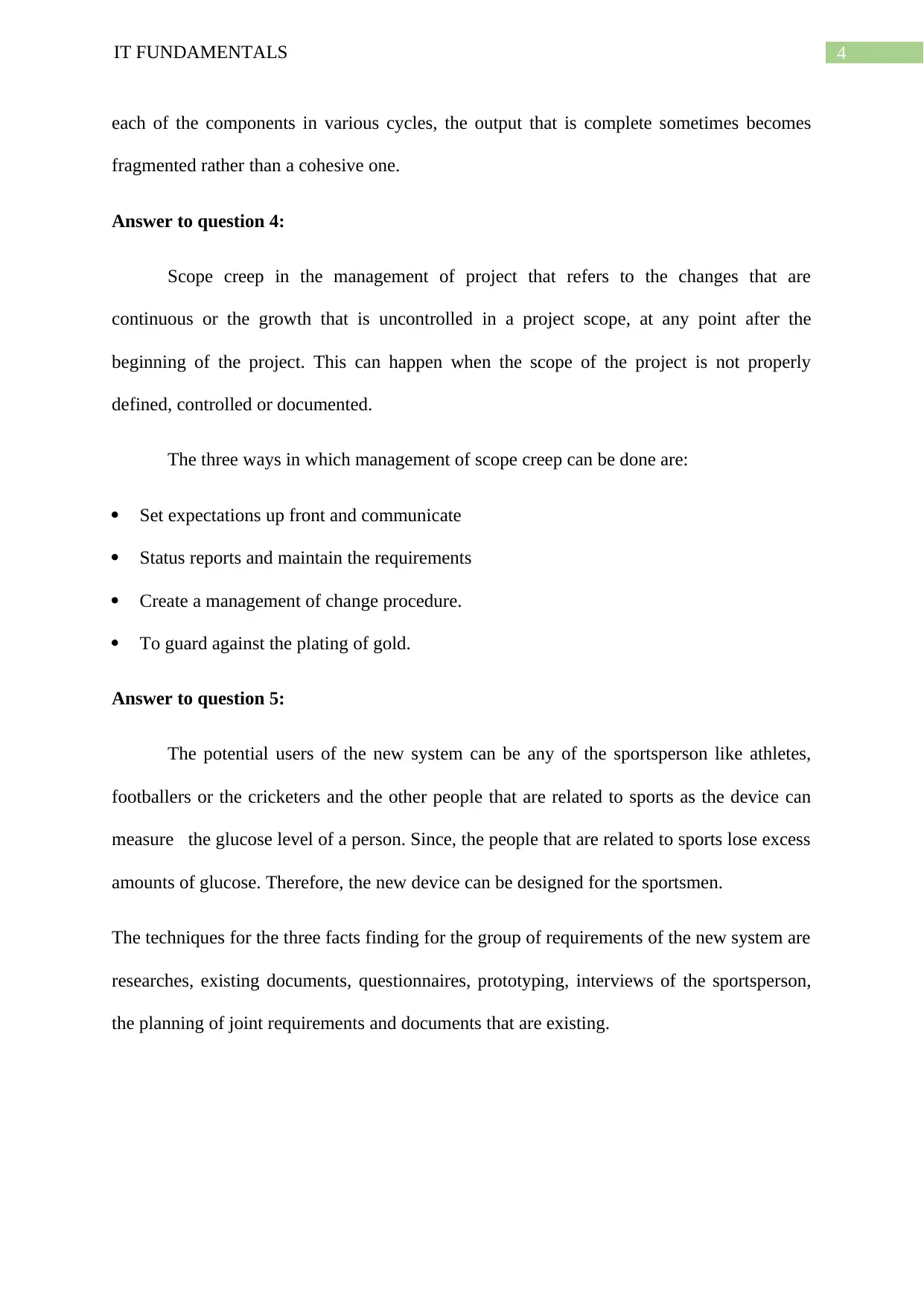
4IT FUNDAMENTALS
each of the components in various cycles, the output that is complete sometimes becomes
fragmented rather than a cohesive one.
Answer to question 4:
Scope creep in the management of project that refers to the changes that are
continuous or the growth that is uncontrolled in a project scope, at any point after the
beginning of the project. This can happen when the scope of the project is not properly
defined, controlled or documented.
The three ways in which management of scope creep can be done are:
Set expectations up front and communicate
Status reports and maintain the requirements
Create a management of change procedure.
To guard against the plating of gold.
Answer to question 5:
The potential users of the new system can be any of the sportsperson like athletes,
footballers or the cricketers and the other people that are related to sports as the device can
measure the glucose level of a person. Since, the people that are related to sports lose excess
amounts of glucose. Therefore, the new device can be designed for the sportsmen.
The techniques for the three facts finding for the group of requirements of the new system are
researches, existing documents, questionnaires, prototyping, interviews of the sportsperson,
the planning of joint requirements and documents that are existing.
each of the components in various cycles, the output that is complete sometimes becomes
fragmented rather than a cohesive one.
Answer to question 4:
Scope creep in the management of project that refers to the changes that are
continuous or the growth that is uncontrolled in a project scope, at any point after the
beginning of the project. This can happen when the scope of the project is not properly
defined, controlled or documented.
The three ways in which management of scope creep can be done are:
Set expectations up front and communicate
Status reports and maintain the requirements
Create a management of change procedure.
To guard against the plating of gold.
Answer to question 5:
The potential users of the new system can be any of the sportsperson like athletes,
footballers or the cricketers and the other people that are related to sports as the device can
measure the glucose level of a person. Since, the people that are related to sports lose excess
amounts of glucose. Therefore, the new device can be designed for the sportsmen.
The techniques for the three facts finding for the group of requirements of the new system are
researches, existing documents, questionnaires, prototyping, interviews of the sportsperson,
the planning of joint requirements and documents that are existing.
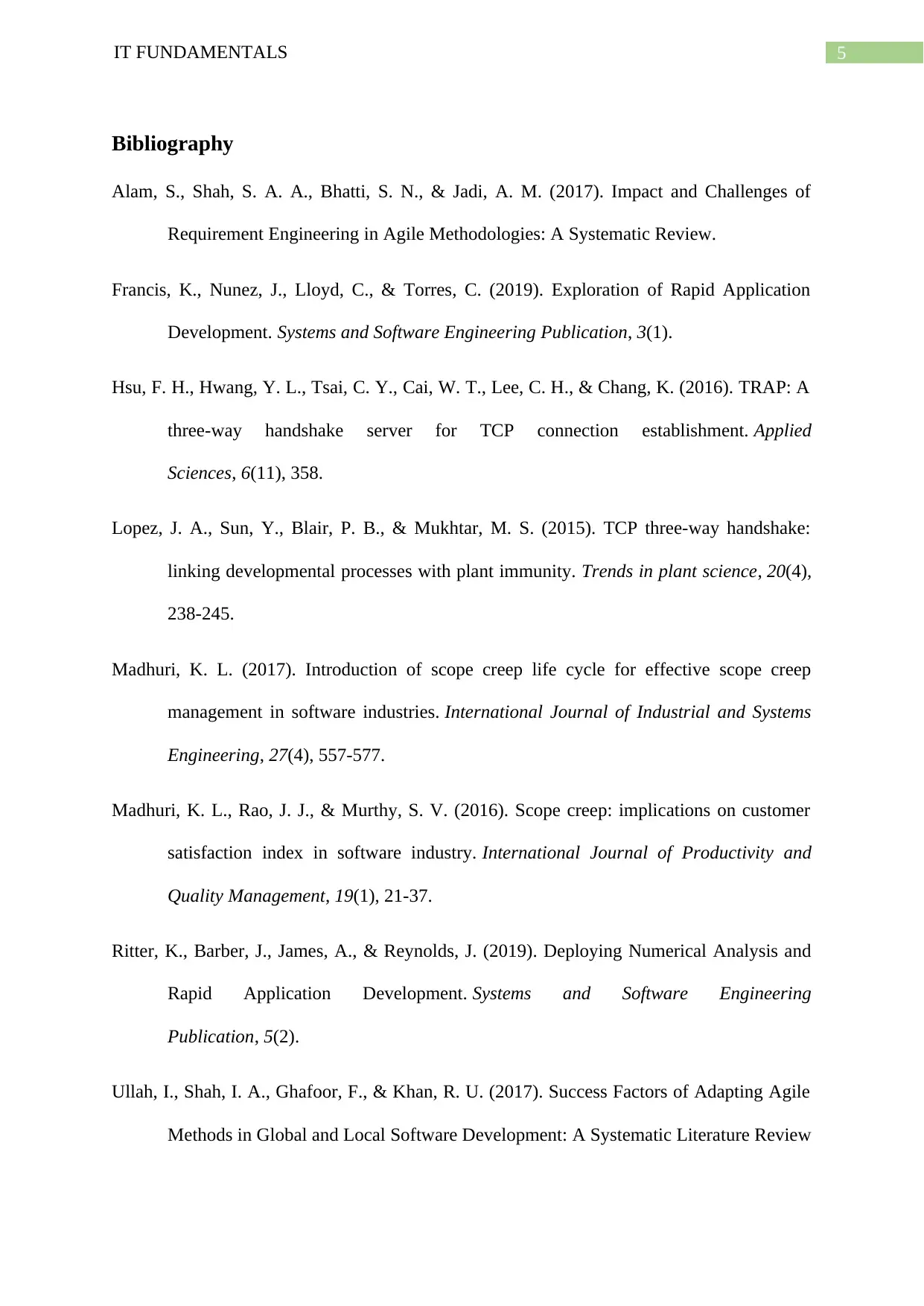
5IT FUNDAMENTALS
Bibliography
Alam, S., Shah, S. A. A., Bhatti, S. N., & Jadi, A. M. (2017). Impact and Challenges of
Requirement Engineering in Agile Methodologies: A Systematic Review.
Francis, K., Nunez, J., Lloyd, C., & Torres, C. (2019). Exploration of Rapid Application
Development. Systems and Software Engineering Publication, 3(1).
Hsu, F. H., Hwang, Y. L., Tsai, C. Y., Cai, W. T., Lee, C. H., & Chang, K. (2016). TRAP: A
three-way handshake server for TCP connection establishment. Applied
Sciences, 6(11), 358.
Lopez, J. A., Sun, Y., Blair, P. B., & Mukhtar, M. S. (2015). TCP three-way handshake:
linking developmental processes with plant immunity. Trends in plant science, 20(4),
238-245.
Madhuri, K. L. (2017). Introduction of scope creep life cycle for effective scope creep
management in software industries. International Journal of Industrial and Systems
Engineering, 27(4), 557-577.
Madhuri, K. L., Rao, J. J., & Murthy, S. V. (2016). Scope creep: implications on customer
satisfaction index in software industry. International Journal of Productivity and
Quality Management, 19(1), 21-37.
Ritter, K., Barber, J., James, A., & Reynolds, J. (2019). Deploying Numerical Analysis and
Rapid Application Development. Systems and Software Engineering
Publication, 5(2).
Ullah, I., Shah, I. A., Ghafoor, F., & Khan, R. U. (2017). Success Factors of Adapting Agile
Methods in Global and Local Software Development: A Systematic Literature Review
Bibliography
Alam, S., Shah, S. A. A., Bhatti, S. N., & Jadi, A. M. (2017). Impact and Challenges of
Requirement Engineering in Agile Methodologies: A Systematic Review.
Francis, K., Nunez, J., Lloyd, C., & Torres, C. (2019). Exploration of Rapid Application
Development. Systems and Software Engineering Publication, 3(1).
Hsu, F. H., Hwang, Y. L., Tsai, C. Y., Cai, W. T., Lee, C. H., & Chang, K. (2016). TRAP: A
three-way handshake server for TCP connection establishment. Applied
Sciences, 6(11), 358.
Lopez, J. A., Sun, Y., Blair, P. B., & Mukhtar, M. S. (2015). TCP three-way handshake:
linking developmental processes with plant immunity. Trends in plant science, 20(4),
238-245.
Madhuri, K. L. (2017). Introduction of scope creep life cycle for effective scope creep
management in software industries. International Journal of Industrial and Systems
Engineering, 27(4), 557-577.
Madhuri, K. L., Rao, J. J., & Murthy, S. V. (2016). Scope creep: implications on customer
satisfaction index in software industry. International Journal of Productivity and
Quality Management, 19(1), 21-37.
Ritter, K., Barber, J., James, A., & Reynolds, J. (2019). Deploying Numerical Analysis and
Rapid Application Development. Systems and Software Engineering
Publication, 5(2).
Ullah, I., Shah, I. A., Ghafoor, F., & Khan, R. U. (2017). Success Factors of Adapting Agile
Methods in Global and Local Software Development: A Systematic Literature Review
⊘ This is a preview!⊘
Do you want full access?
Subscribe today to unlock all pages.

Trusted by 1+ million students worldwide

6IT FUNDAMENTALS
Protocol with Preliminary Results. International Journal of Computers and
Applications, 171(5), 38-42.
Protocol with Preliminary Results. International Journal of Computers and
Applications, 171(5), 38-42.
1 out of 7
Related Documents
Your All-in-One AI-Powered Toolkit for Academic Success.
+13062052269
info@desklib.com
Available 24*7 on WhatsApp / Email
![[object Object]](/_next/static/media/star-bottom.7253800d.svg)
Unlock your academic potential
Copyright © 2020–2025 A2Z Services. All Rights Reserved. Developed and managed by ZUCOL.



